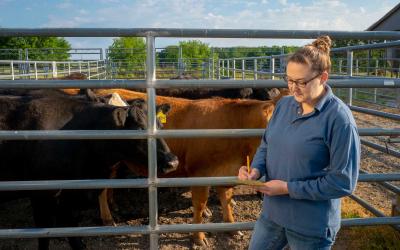Olivia Amundson
SDSU Extension Cow/Calf Field Specialist

In a previous article, Capitalizing on Cow Costs, reducing feed costs to improve cow efficiency was discussed. To continue the conversation, another area of cost reduction is in cull cows, bulls and calf death loss.
Cull cows and bulls as well as calf death loss in the herd can play a significant role in profitability. Producers need to determine their profit margins and decide what options or areas of improvement need focus.
Calf Death Rates
Producers should pay close attention to calf death loss. Calf death loss plays a large roll since more live calves on the ground result in greater gross income. Average national calf loss of calves born dead or calves died before weaning is 6.5 – 7%. Of the 6.5 – 7% of calves, 44.6% of these calves were born dead. The remaining calves that were lost were within 24 hours following birth, more than 24 hours but less than 3 weeks, and prior to weaning.
Factors to decrease calf death loss include:
- Cow Nutrition at Birth: Cows need to be in adequate body condition (5.5 – 6) at time of parturition. This decreases the rate of dystocia and thus calf loss. Cows too thin or over conditioned increase the rate of dystocia.
- Environment: Cows calving in pasture or grass decreases the opportunity for disease and infection compared to cows calving in a dry lot or confined area. Minimizing the amount of mud that a calf is born in can greatly decrease the occurrence of scours or transmissible disease.
- Moving Calving Date: A majority of calves are lost due to adverse weather events. Conditions such as wet, cold, windy, and muddy are stressful for a calf and can decrease immunity. Calving during warmer months of the year can reduce weather-related sickness in calves.
- Provide Shelter: Shelter provided to calves during calving season can mitigate weather-related sickness by providing accommodations away from the weather. This also allows calving to occur during the colder months, which gives advantage to weaning weights in the fall.
- Vaccinate the Calves: Work with your veterinarian to ensure appropriate vaccinations are given to decrease calf death loss prior to weaning.
- Tighten Calving Window: Consider tightening up the calving window to calve earlier, thus increasing weaning weights at time of sale. Decreasing the amount of calves that die and increased weaning weights is one way to offset the cost of production for that cow.
Cull Cows and Bulls
Benchmarks for cull rates are between 14 to 17% in beef herds. While cull females provide opportunity for additional income, the trade-off is potentially fewer heifer calves to sell or the cost of a replacement female. This is the trap and opportunity when managing cull cow options. The cost of an open cow in today’s market averages around $980, it would cost roughly $1,500 or more per head to bring in a bred replacement, whether developed from on the ranch or purchased.
The question then becomes, do we minimize the amount of cull cows, increase the number of cull cows, keep replacements or buy replacements?
This may be the year to consider strategic culling. Cows that may be too thin or hard doers should head down the road. Consider the cost of a pregnant heifer coming into the herd. She will cost a little more to winter than the cow she replaces due to her nutrient requirements, however, that thin cow or hard doer will end up costing you just as much in the end with little prospect of the future.
Consider keeping these cull cows for additional feeding and sell at a more desirable market (see Considerations for Cull Cows). This helps capture costs that may not be there during the seasonal cull cow market. Each operation will be herd specific. Putting pencil to paper will help determine what may be the best decision.
Cow Depreciation
Consider cow depreciation, the second largest expense to the cow calf industry after feed. Depreciation value of a cow is calculated by Purchase Price or Replacement Costs – Salvage Value ÷ Productive Years in the Herd; Example: (1,500 – 980) ÷ 5 = $104. This is without calculating death loss). Average production years for a cow is 3-5 years. Ways to decrease this value include; decreasing replacement female development costs, increase productive years of a cow, and increase salvage value.
Cow Carrying Capacity
Cow carrying capacity can be another way to capitalize on cow costs. This may not be a functional option for every operation. However, increasing carrying capacity can potentially increase costs if not managed correctly. Considerations in weather, facilities, class of livestock, water, feed quality and quantity are just a few things that need thought. However, if able to run more cows per acre, the cost per cow will decrease.
Replacement Options
When producers consider replacing a female, they usually consider a bred heifer. However, it may be more beneficial to purchase a different age group of cows to meet management standards and flexibility. If considering purchasing a bred heifer, it is important to consider that heifer’s development costs against the cost of expected productivity.
To put into perspective the cost to raise a replacement female, producers should operate those females separate from the mature cowherd to identify all production costs. Produce a spreadsheet that incorporates all costs to raise the heifer. Some of these numbers will include; expense of weaned heifer calf, cost of enterprise buying heifer, cost to raise heifer, and cost to buy a bred heifer back. This helps articulate profitability within the replacement heifer world and gives perspective to which management decision is profitable.
Management strategies associated with decreasing cow costs need to be operation specific. Taking the time to evaluate these different options and scenarios can have beneficial financial outcomes for producers.
SDSU extension
